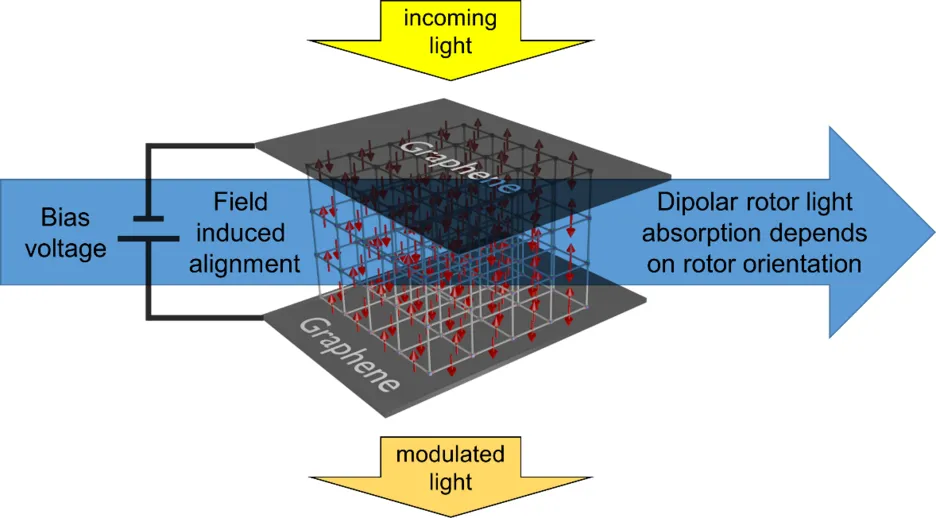| Consortium: | |
| Prof. Dr Rainer Herges University of Kiel Institute of Organic Chemistry | |
| Dr. Ian Howard KIT Institute of Microstructure Technology | |
| PD André Beyer Bielefeld University Faculty of Physics | |
| Project: | Dipolar Molecular Rotors in SURMOFs |
| Abstract: | In a molecular rotor, one part of the molecule (the rotator) can easily revolve with respect to a fixed portion of the molecule (the stator). When the rotator contains a dipole moment one speaks of a dipolar molecular rotor, and an electric field can be used to apply a torque to the rotator that causes it to align with the external field. Moreover, if many dipolar molecular rotors are brought together into an array their dipole moments interact with one another. Given enough free volume is maintained to allow unhindered rotation, these interactions between dipoles can induce collective behaviour. In this way, long-range ordered patterns of dipoles can spontaneously form. Significant effort notwithstanding, such spontaneous ordering has been observed only in a 2D array on a surface to date. The aim of this proposal is to develop 3D arrays of dipolar rotors, and prototype thin film devices that would modulate light transmission by switching the rotators from a spontaneously-ordered state to a field-aligned state. To do this, we focus on developing dipolar molecular rotors from which surface-anchored metal-organic frameworks can be made. With these molecular rotors, the stator provides the link between adjacent metal centres and the rotator is held halfway between the metal centres (and rotates around the axis defined by the stator). Using such structures to host dipolar rotors is optimal because the free volume necessary for rotation can be achieved while at the same time the nearest neighbour distances are kept short enough that dipole-dipole interactions can be significant. Thus, ideal conditions to induce collective behaviour can be reached, plus the thin-film format of the SURMOF is perfectly-suited for subsequent device fabrication.In the initial funding period of the COORNETs priority programme, we successfully implemented the first generation of dipolar rotor linkers in SURMOFs and demonstrated that therein the barrier to rotation is very small (on the order of kJ/mol). These are very encouraging results, but given the dipole moment of these linkers is moderate (2.6 D), we still do not have conclusive evidence of whether collective states are formed. We have also laid groundwork for dielectric- and optical-characterization, and device fabrication (with a total of seven SPP-related publications in the first three-year of funding). In the second period, we will increase the dipole moments and optical absorption of the linkers, focusing on achieving spontaneous ordering. We will also develop thin-film devices with graphene electrodes contacting the dipolar rotor-SURMOF in order to switch its optical transmission. |
| Publications: | |
| S. Hamer, F. Röhricht, M. Jacoby, I. A. Howard, X. Zhang, C. Näther, R. Herges „Synthesis of dipolar molecular rotors as linkers for metal-organic frameworks“ Beilstein J. Org. Chem. 2019, 15, 1331-1338 DOI: 10.3762/bjoc.15.132 | |
| R. Haldar, A. Mazel, M. Krstić, Q. Zhang, M. Jakoby, I. A. Howard, B. S. Richards, N. Jung, D. Jacquemin, S. Diring, W. Wenzel, F. Odobel, C. Wöll „A de novo strategy for predictive crystal engineering to tune excitonic coupling“ Nat. Commun. 2019, 10, 2048 DOI: 10.1038/s41467-019-10011-8 | |
| M. Adams, M. Kozlowska, N. Baroni, M. Oldenburg, R. Ma, D. Busko, A. Turshatov, G. Emandi, M. O. Senge, R. Haldar, C. Wöll, G. U. Nienhaus, B. S. Richards, I. A. Howard „Highly Efficient One-Dimensional Triplet Exciton Transport in a Palladium–Porphyrin-Based Surface-Anchored Metal–Organic Framework“ ACS Appl. Mater. Interfaces 2019, 11, 15688 DOI: 10.1021/acsami.9b03079 | |
| M. Adams, N. Baroni, M. Oldenburg, F. Kraffert, J. Behrends, R. W. MacQueen, R. Haldar, D. Busko, A. Turshatov, G. Emandi, M. O. Senge, C. Wöll, K. Lips, B. S. Richards, I. A. Howard „Reaction of porphyrin-based surface-anchored metal–organic frameworks caused by prolonged illumination“ Phys. Chem. Chem. Phys. 2018, 20, 29142 DOI: 10.1039/C8CP05254A | |
| X. Zhang, E. Marschewski, P. Penner, T. Weimann, P. Hinze, A. Beyer, A. Gölzhäuser „Large-Area All-Carbon Nanocapacitors from Graphene and Carbon Nanomembranes“ ACS Nano 2018, 12, 1030 DOI: 10.1021/acsnano.8b05490 | |
| X. Zhang, E. Marschewski, P. Penner, A. Beyer, A. Gölzhäuser „Investigation of electronic transport through ultrathin carbon nanomembrane junctions by conductive probe atomic force microscopy and eutectic Ga–In top contacts“ J. Appl. Phys. 2017122, 055103 DOI: doi: 10.1063/1.4995533 | |
| X. Zhang, M. Mainka, F. Paneff, H. Hachmeister, A. Beyer, A. Gölzhäuser, T. Huser „Surface-Enhanced Raman Spectroscopy of Carbon Nanomembranes from Aromatic Self-Assembled Monolayers” Langmuir 2018, 34, 2692 DOI: 10.1021/acs.langmuir.7b03956 |
